Results
Wyniki
Summary
- Fabric and the presences of Opx subdivide the sample suite.
- Skeletal Opx in Grt suggests a magmatic origin of Opx-bearing eclogite.
- Lamellar Opx in Cpx suggests a HT origin of Opx-bearing eclogite.
- Foliated eclogite lacks magmatic and lamellar Opx exsolution microstructures from HT.
- Foliated eclogite has Cpx with oriented needles of either Qtz ± Prg or Qtz partially transformed to Ab.
Podsumowanie
- Tkanina i obecność Opx dzielą zestaw próbek.
- Szkieletowy Opx w Grt sugeruje magmowe pochodzenie eklogitu zawierającego Opx.
- Lamelarny Opx w Cpx sugeruje HT pochodzenie eklogitu zawierającego Opx.
- Eklogit foliowany nie ma magmowych i lamelarnych mikrostruktur wydzielających Opx z HT.
- Eklogit foliowany ma Cpx ze zorientowanymi igłami Qtz ± Prg lub Qtz częściowo przekształconymi w Ab.
Eclogite-facies rock textures show a large variation. Individual specimens can be foliated or non-foliated, can have grain sizes of several mm, up to 25 mm in some samples, whereas others have dominantly sub-mm grain size or an apparent bimodal grain size distribution. The eclogite-facies mineral assemblages contain, besides Grt and Cpx, variable amounts of Opx, Ky, Qtz, Rt and opaque mineral phases. In addition, partial recrystallisation reduced grain sizes in some samples. The degree of retrogression varies too, in form of symplectites replacing Cpx and the crystallisation of secondary Amp and Bt. Some key observations are summarised below.
Tekstury skał z fazy eclogite wykazują dużą zmienność. Poszczególne okazy mogą być sfałdowane lub niefałdowane, mogą mieć ziarna o wielkości kilku mm, do 25 mm w niektórych próbkach, podczas gdy inne mają głównie ziarna submilimetrowe lub pozorny bimodalny podział wielkości ziaren. Zespoły mineralne fazy eclogite zawierają, oprócz Grt i Cpx, zmienne ilości Opx, Ky, Qtz, Rt i nieprzezroczystych faz mineralnych. Ponadto częściowa rekrystalizacja zmniejszyła rozmiary ziaren w niektórych próbkach. Stopień retrogresji jest również różny, w postaci symplektytów wymiany Cpx i krystalizacji wtórnych Amp i Bt. Poniżej podsumowano niektóre kluczowe obserwacje.
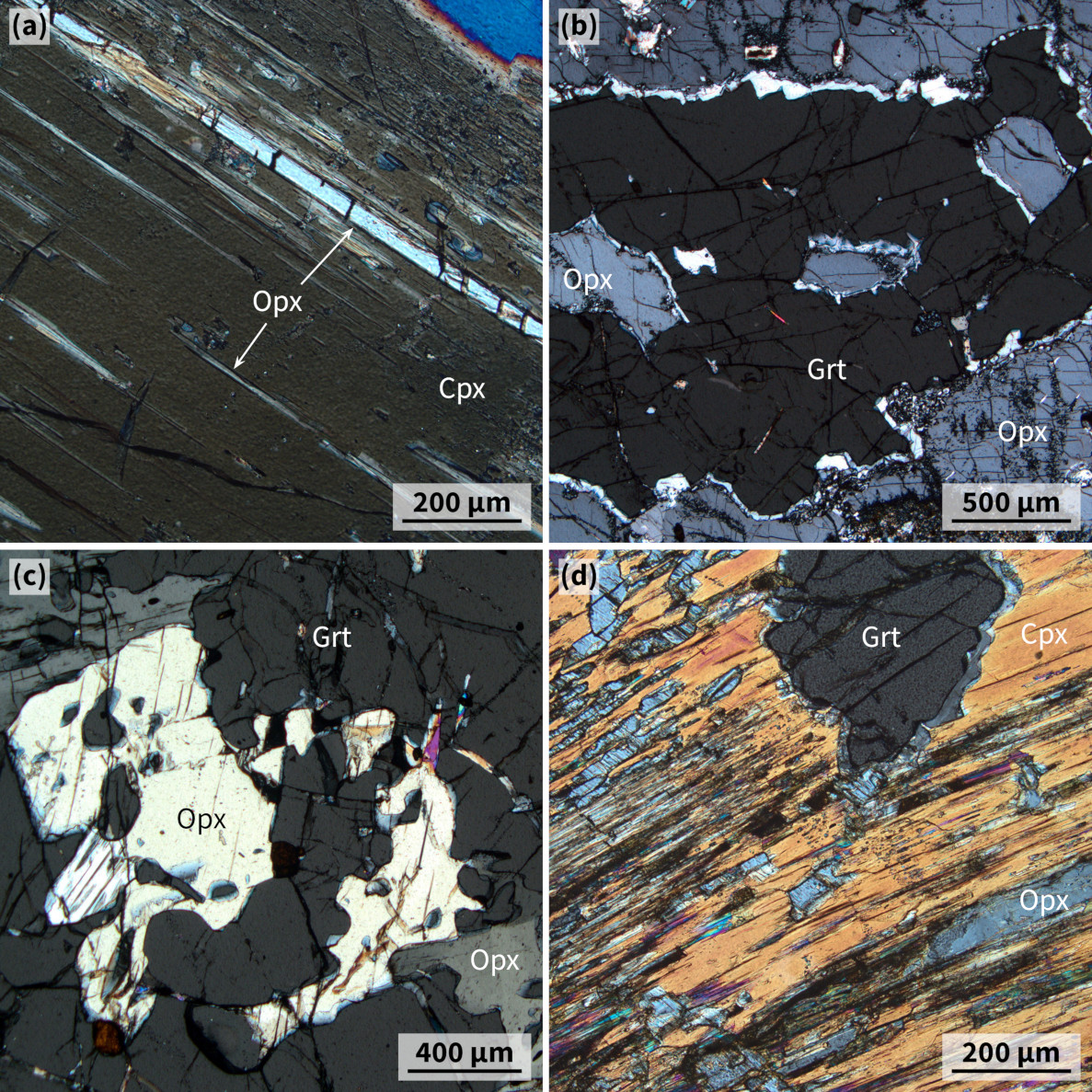
Non-foliated coarse Opx-bearing eclogite contains inclusions with irregular grain shapes that vary from patchy to skeletal (Figure 3b-d). They comprise mainly Grt in both Cpx and Opx and vice versa, consistent with a magmatic co-crystallisation of these minerals. Coarse and fine exsolution lamellae of Opx in coarse Cpx shows that magmatic crystallisation was followed by eclogite cooling (Figure 3a, d).
Niefoliowany gruboziarnisty eklogit zawierający Opx zawiera wtrącenia o nieregularnych kształtach ziaren, które różnią się od niejednolitych do szkieletowych (Rysunek 3b-d). Zawierają one głównie Grt zarówno w Cpx, jak i Opx i odwrotnie, co jest zgodne z magmową ko-krystalizacją tych minerałów. Gruboziarniste i drobnoziarniste lamele wydzielające Opx w gruboziarnistym Cpx wskazują, że po krystalizacji magmowej nastąpiło chłodzenie eklogitu (rysunek 3a, d).
Foliated parts of coarse grained Opx-bearing eclogite have grains with equilibrated boundaries, but have not been observed to contain patchy, skeletal or lamellar shaped inclusions (Figure 4a). This suggests that strain accumulation erased magmatic and ensuing HT microstructures. Needle-shaped inclusions of Qtz + Prg in elongated Cpx grains postdate deformation (Figure 4b, c).
Foliowane części gruboziarnistego eklogitu zawierającego Opx mają ziarna o równowagowych granicach, ale nie zaobserwowano, aby zawierały niejednolite, szkieletowe lub lamelarne wtrącenia (Rysunek 4a). Sugeruje to, że akumulacja naprężeń wymazała mikrostruktury magmowe i wynikające z nich mikrostruktury HT. Inkluzje w kształcie igieł Qtz + Prg w wydłużonych ziarnach Cpx powstały po deformacji (Rysunek 4b, c).
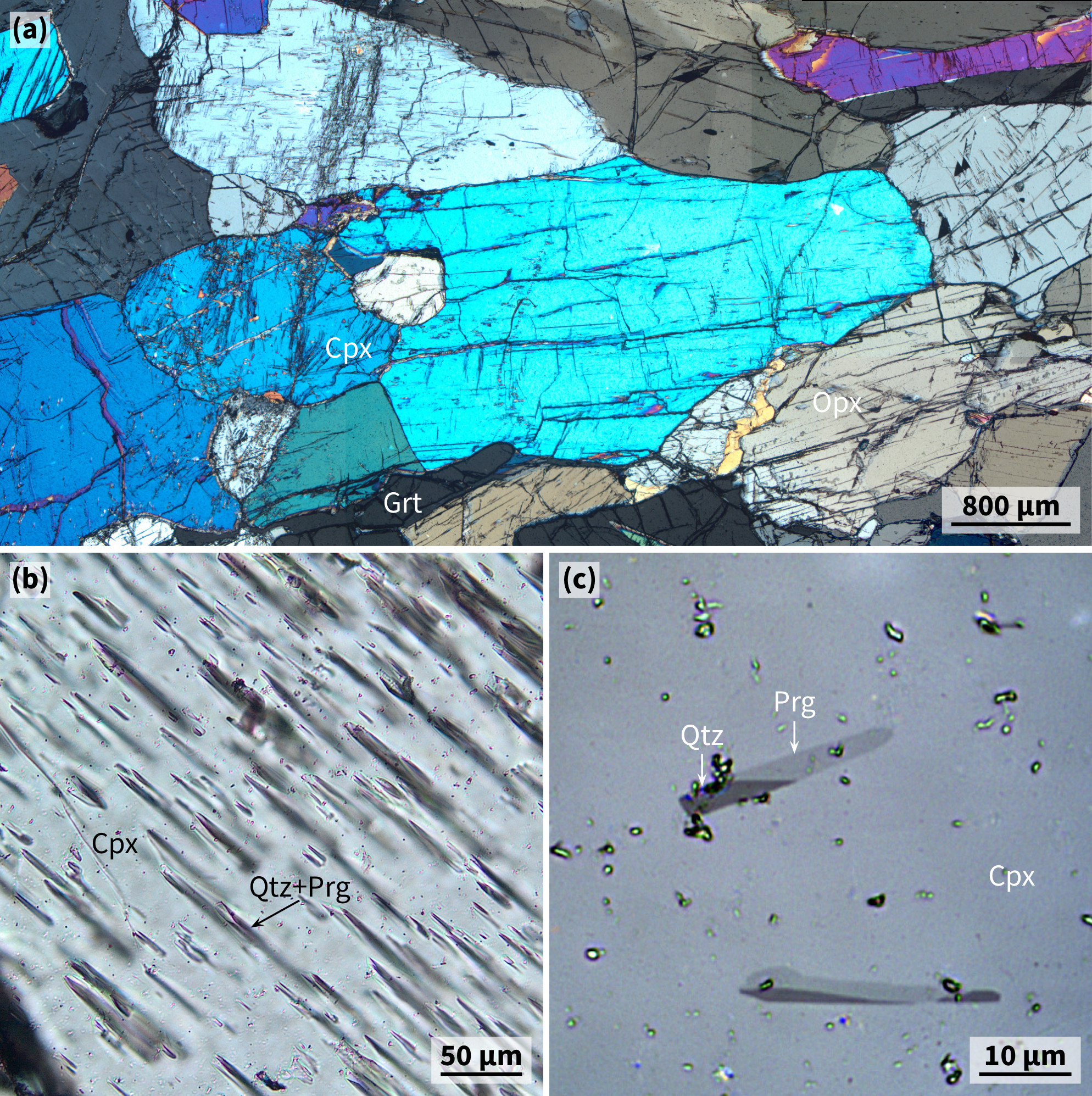

Opx-free eclogite has elongated Cpx that contains in crystal cores acicular inclusions of fresh Qtz or Qtz+Ab or Ab (Figure 5). Theses inclusions have parallel orientation to each other. Interfaces between Qtz inclusions and the Cpx host are straight, whereas those of Ab are irregular (Figure 5b). The latter suggests Ab formation by the breakdown of the jadeite component in Cpx during decompression.
Eklogit wolny od Opx ma wydłużony Cpx, który zawiera w rdzeniach krystalicznych igiełkowe inkluzje świeżego Qtz lub Qtz+Ab lub Ab (Rysunek 5). Inkluzje te mają orientację równoległą do siebie. Interfejsy pomiędzy inkluzjami Qtz i Cpx są proste, podczas gdy te z Ab są nieregularne (Rysunek 5b). To ostatnie sugeruje powstawanie Ab w wyniku rozpadu składnika jadeitowego w Cpx podczas dekompresji.
Summary
- Grt forms two chemical trends depending on the presence of Opx in the mineral assemblage.
- Proportions of CaTs and CaEs in needle-hosting Cpx and integrated Cpx differ as expected for an exsolution origin of the needles.
- Low Al2O3 (<0.4 wt%) Opx occurs in foliated and non-foliated eclogite within UHP and interjacent areas.
Podsumowanie
- Grt tworzy dwa trendy chemiczne w zależności od obecności Opx w zespole minerałów.
- Proporcje CaTs i CaEs w Cpx zawierającym igły i zintegrowanym Cpx różnią się zgodnie z przewidywanym pochodzeniem igieł.
- Opx o niskiej zawartości Al2O3 (<0,4% mas.) występuje w eklogitach sfałdowanych i niefałdowanych w UHP i obszarach przyległych.
Garnet
Granat
Grt average compositions outline low-Ca and high-Ca compositional trends that characterise Opx-bearing and Opx-free eclogite, respectively (Figure 6a). Each compositional group of Grt covers two compositional groups of eclogite using the classification of Coleman et al. (1965). Each of these two compositional ranges forms a separate chemical trend on diagrams of Grt CaO versus Cr2O3 contents (Figure 6b). All these trends overlap those of eclogitic and pyroxenitic mantle Grt from global and regional data sets (Grütter et al., 2004; Aulbach et al., 2020; Spengler et al., 2021).
Średnie składy Grt zarysowują trendy składowe o niskiej i wysokiej zawartości Ca, które charakteryzują odpowiednio eclogit zawierający Opx i eclogit bez Opx (Rysunek 6a). Każda grupa składowa Grt obejmuje dwie grupy składowe eklogitu przy użyciu klasyfikacji Colemana et al. (1965). Każdy z tych dwóch zakresów składu tworzy oddzielny trend chemiczny na wykresach zawartości Grt CaO w stosunku do Cr2O3 (Rysunek 6b). Wszystkie te trendy pokrywają się z trendami eklogitycznego i piroksenitycznego płaszcza Grt z globalnych i regionalnych zestawów danych (Grütter et al., 2004; Aulbach et al., 2020; Spengler et al., 2021).
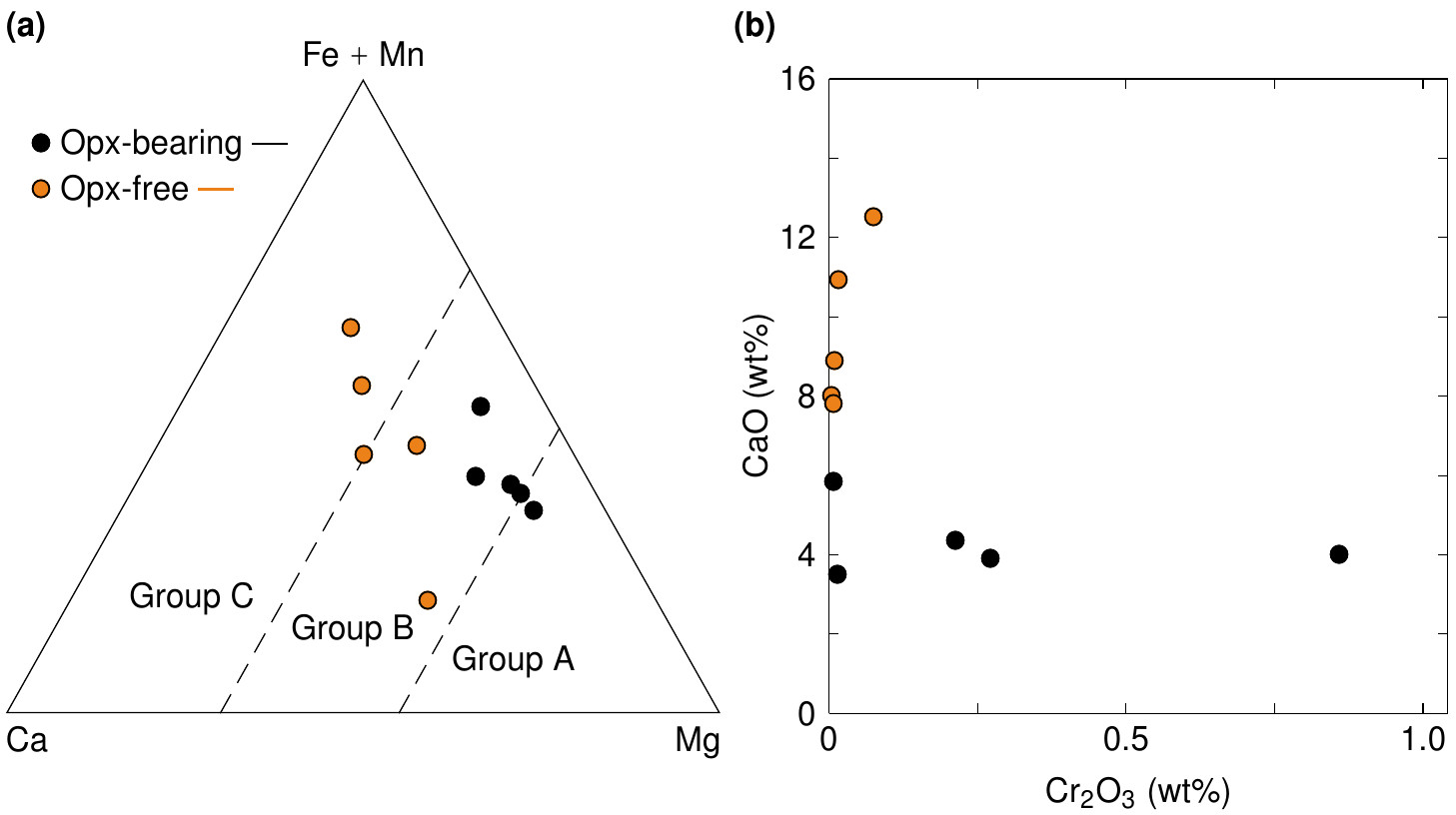
Clinopyroxene
Klinopiroksen
Average compositions of needle-bearing Cpx vary largely in Na content (0–46 mol% Jd) and show no clear systematics between samples from HP and UHP areas (Figure 7a). Reconstructed mineral core compositions (host + needles) are non-stoichiometric compositions that translate to higher CaEs and lower CaTs components than the host Cpx (Figure 7b). Endmember proportions of individual grain compositions suggest that an exsolution origin of the needles would have increased the CaTs component of the host grain at the expense of its CaEs component to a ratio of approximately 1:2 (Figure 7b).
Średnie składy igieł Cpx różnią się znacznie zawartością Na (0–46 mol% Jd) i nie wykazują wyraźnej systematyki pomiędzy próbkami z obszarów HP i UHP (Rysunek 7a). Zrekonstruowane składy rdzenia mineralnego (gospodarz + igły) są składami niestechiometrycznymi, które przekładają się na wyższe CaEs i niższe składniki CaTs niż Cpx gospodarza (Rysunek 7b). Proporcje końcowe poszczególnych składów ziaren sugerują, że pochodzenie igieł z roztworu zwiększyłoby składnik CaTs ziarna gospodarza kosztem jego składnika CaEs do stosunku około 1:2 (Rysunek 7b).
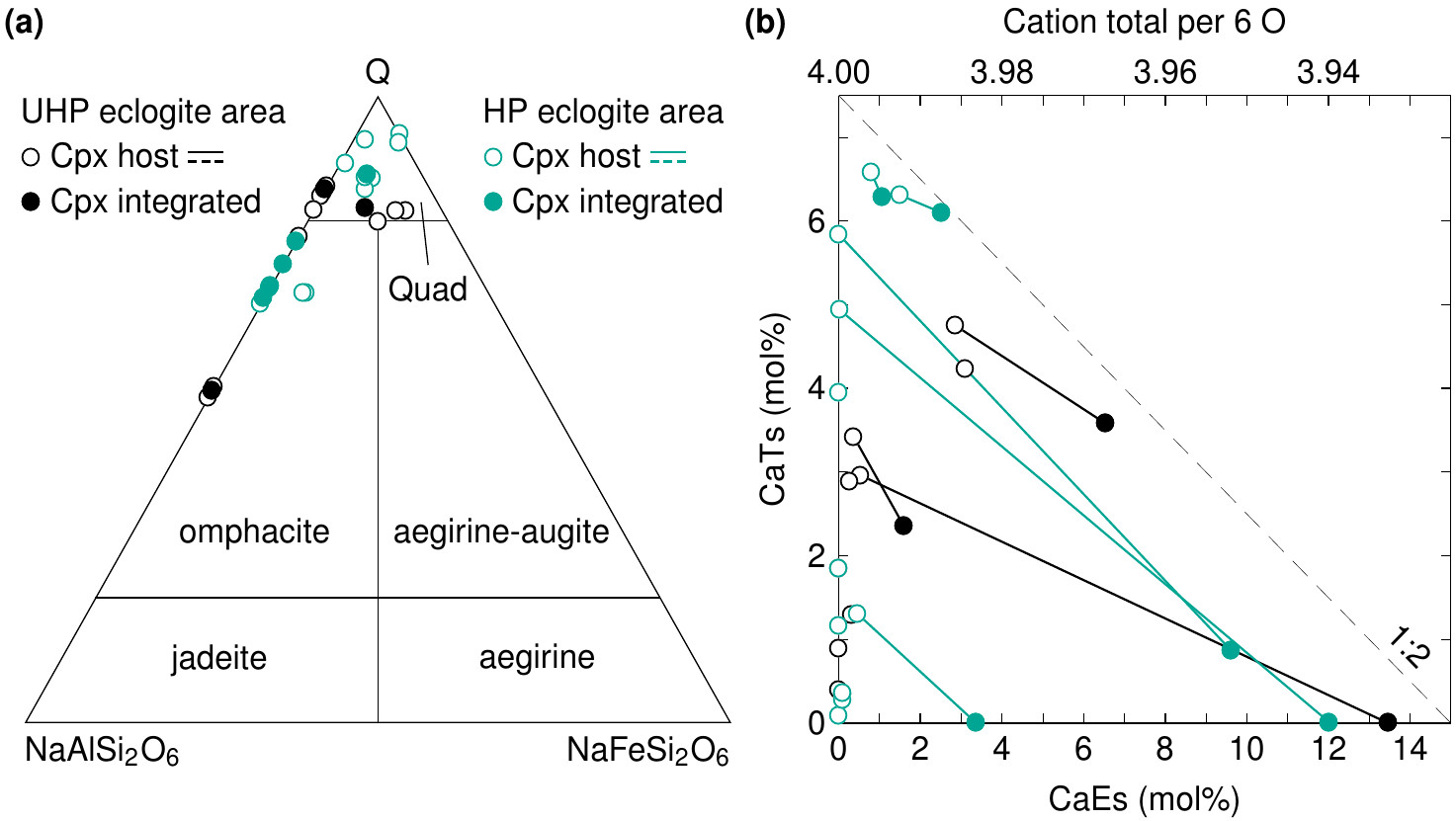
Orthopyroxene
Ortopiroksen
Opx grain cores are magnesian (73–86 mol% En). The largest grains (mm-size) have cores with low Al2O3 contents in the range of 0.17–0.37 wt% irrespective of fabric and area affinity of the eclogites (Figures 8 and 9).
Rdzenie ziaren Opx są magnezowe (73–86 mol% En). Największe ziarna (wielkości mm) mają rdzenie o niskiej zawartości Al2O3 w zakresie 0,17–0,37% mas. niezależnie od tkaniny i powinowactwa obszarowego eklogitów (ryc. 8 i 9).
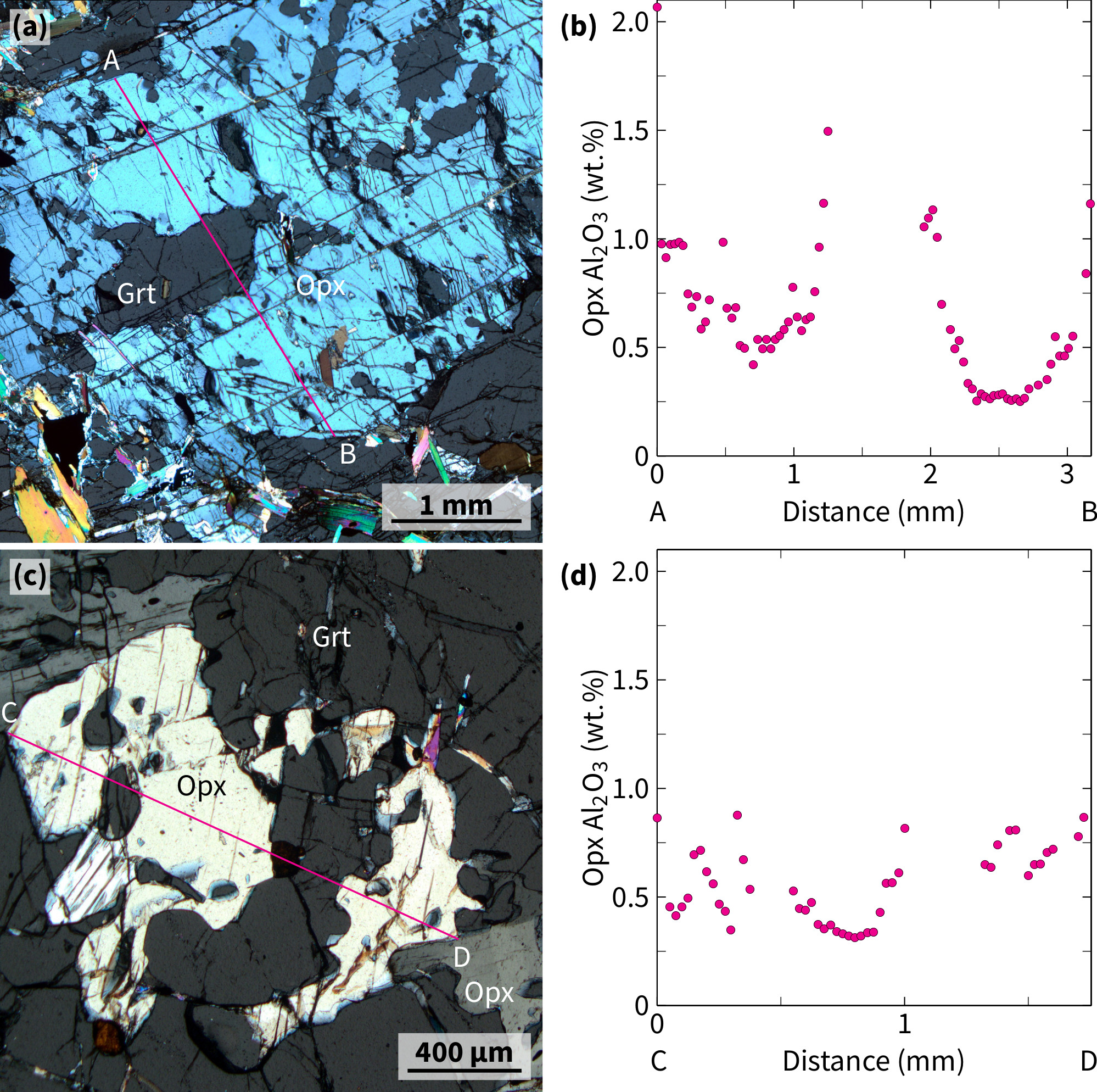
Elevated concentrations of alumina at crystal margins and selected cleavage planes argue for an overprint of the primary mineral chemistry by Al diffusion into the crystal during eclogite retrogression (exhumation) and against growth zoning as the cause for the intracrystalline Al concentration variation. High alumina contents with maximal values between ∼1 wt% and ∼2 wt% characterise Opx grain rims, grains of small grain size and grains that occur in samples with abundant secondary minerals (e.g. Amp, Bt, symplectite).
Podwyższone stężenia tlenku glinu na krawędziach kryształów i wybranych płaszczyznach rozszczepienia przemawiają za nadrukiem pierwotnego składu mineralnego przez dyfuzję glinu do kryształu podczas retrogresji eklogitu (ekshumacji) i przeciwko strefowaniu wzrostu jako przyczynie wewnątrzkrystalicznej zmienności stężenia glinu. Wysokie zawartości tlenku glinu z maksymalnymi wartościami pomiędzy ∼1% mas. a ∼2% mas. charakteryzują obrzeża ziaren Opx, ziarna o małych rozmiarach i ziarna występujące w próbkach z dużą ilością minerałów wtórnych (np. Amp, Bt, symplektyt).

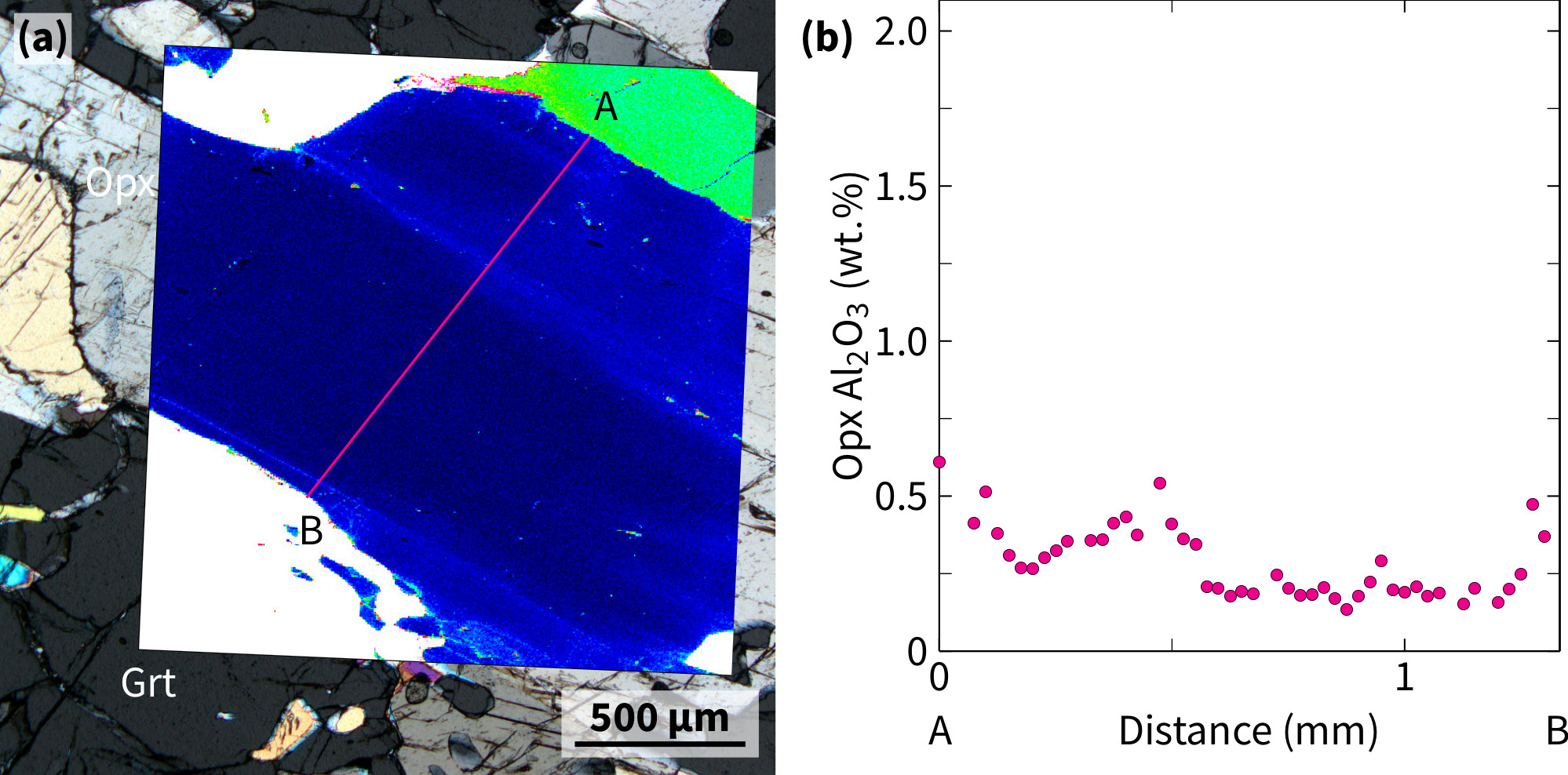
References
Aulbach et al., 2020, Journal of Petrology 368–369:105588
Coleman et al., 1965, Geological Society of America Bulletin 76:483–508
Grütter et al., 2004, Lithos 77:841–857
Morimoto et al., 1988, American Mineralogist 73:1123–1133
Spengler et al., 2021, Journal of Petrology 62:egab008
Summary
- Coastal Opx eclogite within and between UHP areas equilibrated in the diamond stability field.
- Low Al2O3 (0.17 wt%) Opx suggests exhumation of eclogite and enclosing gneisses from minimum 150 km depth.
Podsumowanie
- Przybrzeżny eklogit Opx wewnątrz i pomiędzy obszarami UHP zrównoważył się w diamentowym polu stabilności.
- Niska zawartość Al2O3 (0,17% mas.) Opx sugeruje ekshumację eklogitu i otaczających go gnejsów z głębokości co najmniej 150 km.

Four eclogites that contain Opx but few secondary minerals yielded metamorphic P–T estimates within narrow ranges (Figure 10) of approximately 4.1–5.2 GPa and 800–850 °C if Opx was used for the temperature calculation (3.7–5.5 GPa and 770–850 °C if Cpx was used). Estimates obtained using the mineral chemistry of an Opx-bearing eclogite sample that is rich in secondary minerals were lower in pressure (2.1–2.2 GPa) but similar in temperature (800–820 °C), irrespective of the calibration applied. Therefore, the mineral chemistry of Opx-bearing eclogites records a metamorphism in the diamond stability field for occurrences within and interjacent to UHP areas. Estimates of the conditions of peak metamorphism are indistinguishable from one another except where they have been obscured by retrogression.
Cztery eklogity, które zawierają Opx, ale niewiele minerałów wtórnych, dały metamorficzne oszacowania P–T w wąskich zakresach (Rysunek 10) około 4,1–5,2 GPa i 800-850 °C, jeśli do obliczenia temperatury użyto Opx (3,7–5,5 GPa i 770-850 °C, jeśli użyto Cpx). Oszacowania uzyskane przy użyciu składu mineralnego próbki eklogitu zawierającego Opx, który jest bogaty w minerały wtórne, były niższe pod względem ciśnienia (2,1–2,2 GPa), ale podobne pod względem temperatury (800–820 °C), niezależnie od zastosowanej kalibracji. W związku z tym skład mineralny eklogitów zawierających Opx rejestruje metamorfizm w polu stabilności diamentu dla wystąpień w obszarach UHP i sąsiadujących z nimi. Oszacowania warunków szczytowego metamorfizmu są nierozróżnialne od siebie, z wyjątkiem przypadków, w których zostały one przesłonięte przez retrogresję.
Opx-free eclogites yielded temperatures equal to or lower than those calculated for Opx-bearing eclogites (Figure 10). There is no systematic difference between the calculated maximum metamorphic conditions for samples from the UHP eclogite areas and those in the interjacent HP eclogite area, and there is no systematic difference between maximum metamorphic temperatures for Opx-bearing and Opx-free eclogites.
Eklogity niezawierające Opx dały temperatury równe lub niższe niż te obliczone dla eklogitów zawierających Opx (Rysunek 10). Nie ma systematycznej różnicy pomiędzy obliczonymi maksymalnymi warunkami metamorficznymi dla próbek z obszarów eklogitów UHP i tych z sąsiedniego obszaru eklogitów HP, a także nie ma systematycznej różnicy pomiędzy maksymalnymi temperaturami metamorficznymi dla eklogitów zawierających Opx i bez Opx.
References
Referencje
Bose and Ganguly, 1995, American Mineralogist 80:231–238
Brey and Köhler, 1990, Journal of Petrology 31:1353–1378
Day, 2012, American Mineralogist 97:52–62
Nimis and Taylor, 2000, Contributions to Mineralogy and Petrology 139:541–554
Schmidt and Poli, 1998, Earth and Planetary Science Letters 163:361–379
Bose i Ganguly, 1995, American Mineralogist 80:231–238
Brey i Köhler, 1990, Journal of Petrology 31:1353–1378
Day, 2012, American Mineralogist 97:52–62
Nimis i Taylor, 2000, Contributions to Mineralogy and Petrology 139:541–554
Schmidt i Poli, 1998, Earth and Planetary Science Letters 163:361–379